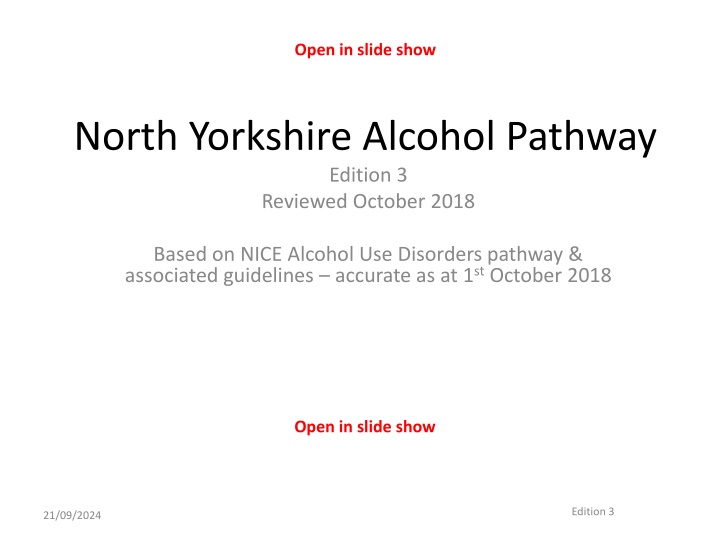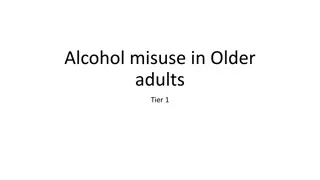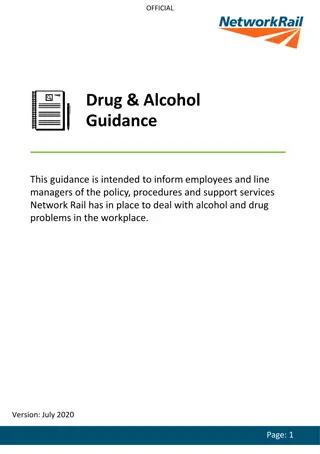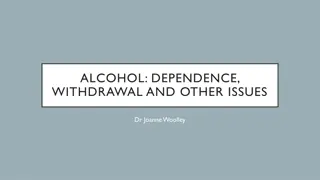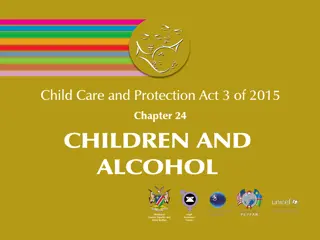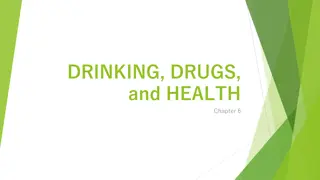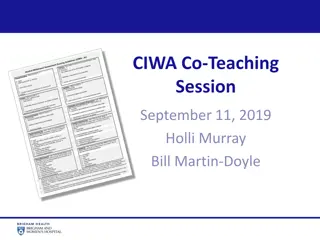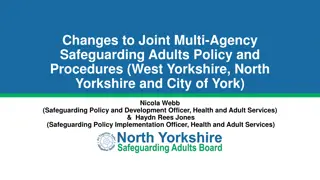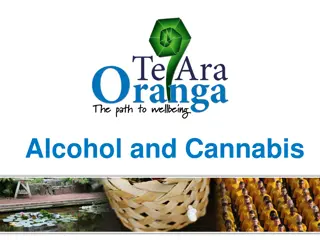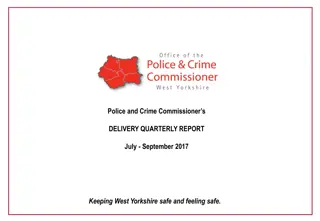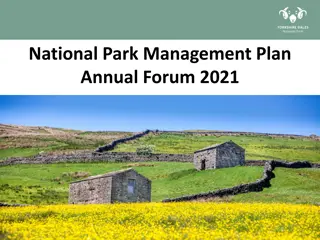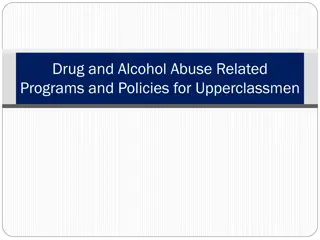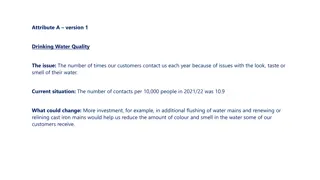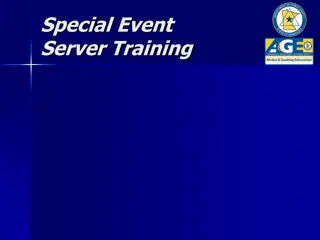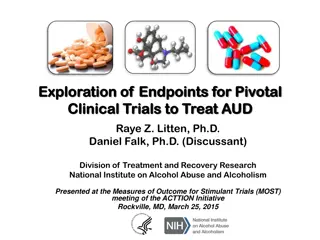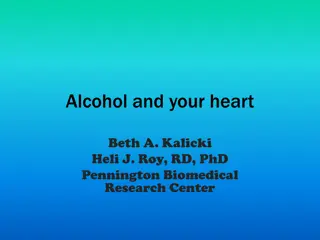North Yorkshire Alcohol Pathway Review - Edition 3, October 2018
This document outlines the North Yorkshire Alcohol Pathway Edition 3, reviewed in October 2018 based on NICE guidelines. It provides detailed steps for assessing alcohol consumption patterns, risk levels, and appropriate interventions for individuals of different age groups. Urgent responses and referrals are emphasized for those in need of immediate assistance, with key resources and contact information listed. The pathway includes screening questionnaires, risk assessments, and referrals to specialist services for further evaluation and support. Consent is prioritized throughout the process to ensure the individual's involvement in decision-making.
Download Presentation

Please find below an Image/Link to download the presentation.
The content on the website is provided AS IS for your information and personal use only. It may not be sold, licensed, or shared on other websites without obtaining consent from the author.If you encounter any issues during the download, it is possible that the publisher has removed the file from their server.
You are allowed to download the files provided on this website for personal or commercial use, subject to the condition that they are used lawfully. All files are the property of their respective owners.
The content on the website is provided AS IS for your information and personal use only. It may not be sold, licensed, or shared on other websites without obtaining consent from the author.
E N D
Presentation Transcript
Open in slide show North Yorkshire Alcohol Pathway Edition 3 Reviewed October 2018 Based on NICE Alcohol Use Disorders pathway & associated guidelines accurate as at 1stOctober 2018 Open in slide show Edition 3 21/09/2024
Urgent response required call 999 opportunity and continue Seek to identify and address at earliest to review need If you are worried about a child or a young person or a vulnerable adult T: 01609 780780 Website (North Yorkshire County Council Safeguarding) Do you, or somebody you know, need help with daily living or to find out about children s social care options Social Care Website T: 01609 780780 Gain consent from adults prior to referral 10 - 15 years old, 9 years old and under 16 years old or older or individual has learning disability and is under 25 years old Gain consent and assist individual to complete validated alcohol screening questionnaire to assess their pattern of alcohol consumption and associated risk or harm, and the appropriate course of action. Refer to the Children and Families Service: T: 01609 780780 Website Contact Compass REACH T: 0800 008 7452 Website If time is limited: FAST* If time is limited: MSASQ* AUDIT-C GOLD STANDARD Notes: Compass REACH will liaise with other local Healthy Child Programme services if another service can better meet the needs of a young person FAST score: equal to or greater than 3 Is a positive screen AUDIT-C score: 5 or more Score 4 or more if 65 years or over Is a positive screen and indicates possible increasing, higher risk or dependent drinking M-SASQ score 2 or more Is a positive screen Compass REACH will liaise with North Yorkshire Horizons if an under 18 year old is assessed and needs a pharmacological intervention. this will be provided by North Yorkshire Horizons in conjunction with Compass REACH Gain consent and assist client to complete full AUDIT (10 questions) AUDIT score 0-7 (refer to action for score 8-19 if over 65 years and score 7 or more) Low risk drinking AUDIT score 8-19 AUDIT score 20+ Indicates possible dependence AUDIT score 7 and over 65 years old Score 8-15 indicates hazardous/ increasing risk drinking Score 16-19 indicates harmful/ higher risk drinking Delivery of a brief intervention is not shown to be effective offer referral to specialist service for assessment North Yorkshire Horizons and Compass REACH will liaise and agree which service can best meet the needs of 18-19 year olds (up to 25 years if they have a learning disability). This may involve a joint assessment. In most cases new referrals for over 18 year olds will be assessed by North Yorkshire Horizons in the first instance Over 18 s only: 16/17 year old: Gain consent and refer to Compass REACH T: 0800 008 7452 Reinforce low risk drinking guidelines as part of broader conversation Provide alcohol units leaflet 16/17 years old: Deliver structured alcohol brief intervention(s) and consider contacting North Yorkshire Horizons SPOC for details of local mutual aid/ peer support groups SPOC: 01723 330730 North Yorkshire Horizons Gain consent and refer to Compass REACH/ T: 0800 008 7452 Over 18 years old: Gain consent and refer to North Yorkshire Horizons/T: 01723 330730 Include details of risk assessment on referral if individual is deemed to pose a risk to staff/ others 21/09/2024
Key resources Alcohol consumption and associated risk individual risk level definitions: Key resources (service users): Alcohol identification and brief advice One You drink less North Yorkshire Horizons Compass REACH NHS Choices As with most activities, drinking alcohol carries a degree of risk. In 2016, new guidelines were developed by the UK Chief Medical Officer to enable people to make informed choices about their alcohol intake. The new guidelines were agreed on the basis of evidence on the health effects of alcohol, predominantly related to the relationship between alcohol consumption and increased risk of developing disease. Alcohol identification and brief advice (IBA) aims to identify and influence patients who are increasing or higher risk drinkers. Key resources (professionals): IBA is most impactful when it helps identify and advise individuals who are not dependent on alcohol, but whose drinking is increasing their risk of a wide range of ill health linked to drinking alcohol. In addition, the intervention will identify dependent drinkers who could benefit from further specialist support. The Chief Medical Officers guideline for both men and women is that: To keep health risks from alcohol to a low level it is safest not to drink more than 14 units a week on a regular basis. If you regularly drink as much as 14 units per week, it is best to spread your drinking evenly over 3 or more days. If you have one or two heavy drinking episodes a week, you increase your risks of death from long-term illness and from accidents and injuries. The risk of developing a range of health problems (including cancers of the mouth, throat and breast) increases the more you drink on a regular basis. If you wish to cut down the amount you drink, a good way to help achieve this is to have several drink-free days each week. Training: Alcohol Identification and Brief Advice training (North Yorkshire) Royal College of General Practitioners (Spectrum Learn and Develop) Alcohol Level 1 Cochrane Library research suggests that IBA can reduce weekly drinking by 12% on average. Reducing regular consumption by any amount reduces the risk of ill health. Guidance on delivering alcohol identification and brief advice: Alcohol Identification and Brief Advice E-Learning website Screening and brief interventions (select prevention and then screening and brief interventions ) Health Matters: Preventing ill health through action on alcohol and tobacco Hazardous (increasing risk) drinking: A pattern of alcohol consumption that increases someone's risk of harm. Some would limit this definition to the physical or mental health consequences (as in harmful use). Others would include the social consequences. The term is currently used by the World Health Organization to describe this pattern of alcohol consumption. It is not a diagnostic term. Consumption (units per week): Drinking more than 14 units a week, but less than 35 units a week for women. Drinking more than 14 units a week, but less than 50 units for men. Alcohol Identification and Brief Advice E-Learning website Making Every Contact Count (MECC) - Alcohol Local services: Contact Claire Lawrence for local resources: Claire.Lawrence@northyorks.gov.uk North Yorkshire Horizons Compass REACH NYCC Live Well Harmful (higher risk) drinking A pattern of alcohol consumption that is causing mental or physical damage (medical diagnostic criteria: ICD-10, DSM-V). Consumption (units per week): Drinking 35 units a week or more for women. Drinking 50 units a week or more for men. Alcohol Resources: NICE alcohol pathway World Health Organisation: The Alcohol Use Disorders Questionnaire, Guidelines for Use in Primary Care Substance misuse in older people: Royal College of Psychiatry (2015) Coexisting severe mental illness and substance misuse Alcohol dependence is characterised by craving, tolerance and a preoccupation with alcohol and continued drinking, in spite of harmful consequences (for example liver disease, depression). Alcohol dependence is also associated with increased criminal activity, domestic violence and an increased rate of significant mental and physical disorders (NICE, 2011). Source. Edition 3
Editorial Group Angela Hall Health Improvement Manager, Public Health, North Yorkshire County Council Claire Robinson - Health Improvement Manager, Public Health, North Yorkshire County Council Ruth Everson - Health Improvement Manager, Public Health, North Yorkshire County Council Dolly Dalton North Yorkshire Horizons Ted Haughey North Yorkshire Horizons Dr Linda Harris North Yorkshire Horizons & CEO Spectrum CIC (Clinical Partner, North Yorkshire Horizons) Dr Hany El-Sayeh Consultant Psychiatrist, Tees Esk Wear Valley NHS Trust Paddy Chandler North Yorkshire Horizons (now Stronger Communities, North Yorkshire County Council) Allan Wescott Head of Custody, North Yorkshire Police Lisa Gale, Service Manager, Compass REACH Jack Davies Community Pharmacy North Yorkshire Dr John Crompton Chair, YorLMC Chris Appleyard Locality Head Care and Support, Adult Social Care Operations, North Yorkshire County Council Tom Heywood Paramedic Practitioner/ Clinical Pathway Advisor , Yorkshire Ambulance Service NHS Trust Dawn Jessop Prisons and Leeds and the Humber Custody, Leeds Community Health Dallas Frank - North Yorkshire County Council Vicki Beere Service Manager, Project 6, Bradford Bryn Hoyle Dual Diagnosis Social Worker, North Yorkshire County Council Karen Jordan North Yorkshire Horizons Dr Raul Perez Consultant Psychiatrist, Tees Esk Wear Valley NHS Trust Carly Walker, Health Improvement Manager, Public Health, North Yorkshire County Council Tracy Mikkleson-Edwards North Yorkshire Horizons Steve Harrison Office of Police and Crime Commissioner for North Yorkshire Peter Hopkins - Service Manager, North Yorkshire County Council Rachel Newton - North Yorkshire Horizons Helena Nowell - NHS Vale of York CCG James Parkes North Yorkshire Safeguarding Children s Board, Board Manager Andy Pearson - North Yorkshire Horizons Dawn Taylor - Team Manager Emergency Duty Team, North Yorkshire County Council Mark Vidgen - North Yorkshire Horizons Stephen Wright - HAS Sensory Service Manager, North Yorkshire County Council Jill Boak, Social Inclusion Officer (Homelessness Prevention), North Yorkshire County Council Sam Bainbridge Office of Police and Crime Commissioner for North Yorkshire Representatives from Scarborough and Ryedale CCG, Hambleton, Richmondshire and Whitby CCG, Harrogate CCG, VoY CCG and Airedale, Wharfedale and Craven CCG were corresponding members of the Alcohol Pathway Task and Finish Group throughout development, and corresponding members of the annual review group. 21/09/2024 Edition 3
